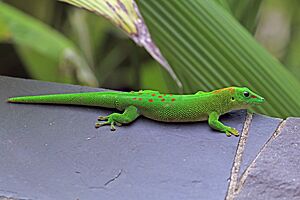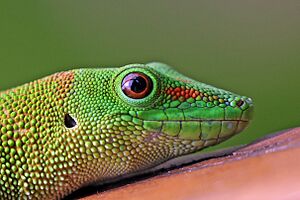Phelsuma grandis facts for kids
Quick facts for kids Phelsuma grandis |
|
|---|---|
 |
|
| Conservation status | |
| Scientific classification | |
| Genus: |
Phelsuma
|
| Species: |
grandis
|
 |
|
| Synonyms | |
|
|
The Madagascar giant day gecko (scientific name: Phelsuma grandis) is a large, colorful lizard. It is a type of day gecko, which means it is active during the day. These geckos live in trees and are native to the forests of northern Madagascar.
There are over 70 different kinds of day geckos in the Phelsuma group. The Madagascar giant day gecko is known for its big size. It eats insects, other small creatures, and sweet plant juices. Many people also keep these geckos as pets.
Contents
About the Madagascar Giant Day Gecko
The scientific name Phelsuma comes from the last name of a Dutch doctor, Murk van Phelsum. The word grandis is Latin for "great" or "large." This name perfectly describes this big gecko!
Scientists used to think this gecko was a subspecies of another gecko. But in 2007, they found enough differences to make it its own species. This was based on how it lives in its environment.
What Does the Giant Day Gecko Look Like?
This lizard can grow to be about 9 to 11 inches (23 to 28 cm) long. Female geckos are usually a bit smaller than males. Their bodies are a bright green, and sometimes they can even be bluish-green.
They have a red stripe that goes from their nose to their eye. On their back, you might see red dots or bars. These red marks can look different on each gecko. Some might even have small blue spots.
Adult geckos can have large sacs on their necks. These sacs store calcium, which is important for their health. Young geckos often have more red markings than their parents. But as they grow, some of these marks fade away. The gecko's belly is usually a creamy white or light yellow.
When these geckos feel stressed, their colors can get darker. The green turns a dark green, and the red marks become more orange.
Where Do Giant Day Geckos Live?
These geckos are found all over northern and northwest Madagascar. They live in tropical and subtropical forests.
They have also been brought to other places by people. You can now find small groups of them in Florida and Hawaii. They were also introduced to Reunion Island and Mauritius. In Mauritius, they have spread a lot and are now seen as a threat to the local wildlife.
How Do Giant Day Geckos Behave?
Male giant day geckos can be quite protective of their space. They usually do not let other males into their area. They only allow females to enter. If a male and female are kept together in a small space, the male might sometimes hurt the female. If this happens, they need to be separated.
When geckos are ready to breed, they might shake their tails or bodies. They also make sounds. If a female does not want to mate, she might turn a darker green.
Day geckos can move slowly and carefully. But if they get scared, they can move incredibly fast! They are also very good at escaping from their homes if they are kept as pets. Giant day geckos do not have eyelids. So, to keep their eyes clean, they often lick them.
What Do Giant Day Geckos Eat?
These day geckos eat different kinds of insects and other small creatures without backbones. Sometimes, they might even eat very small animals with backbones. They also enjoy licking soft, sweet fruits, pollen, and nectar from flowers.
Reproduction and Life Cycle
The breeding season for giant day geckos is usually from December to June. During this time, a female can lay several pairs of eggs. The baby geckos will hatch from their eggs after about 48 to 80 days. The time it takes depends on the temperature around the eggs.




